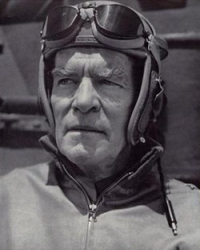
 |
|
|
||
|
Adna Romanza Chaffee, Jr. |
||||
|
Graduate, U.S. Military Academy, Class of 1906 Engagements: • World War I (1914 - 1918) |
||||
| Biography: | ||||
|
Adna Romanza Chaffee, Jr. Adna Romanza Chaffee, Jr. was born on 23 September 1884 in Junction City, KS, the son of famed Indian fighter, Adna Romanza Chaffee. He graduated from the U.S. Military Academy in 1906, ranking 31st in his class of 78 graduates. He was commissioned a Second Lieutenant of Cavalry in 1906 and won recognition as the "Army's finest horseman." His first tour of duty was with the 15th U.S. Cavalry as part of the Army of Cuban Pacification. He was then assigned to the Mounted Services School at Fort Riley, KS, from 1907-11, where he Commanded the mounted detachment serving the students and staff of the Army War College. He was also a member of American Equestrian Teams that competed world-wide. He attended a French Cavalry School for a year, returning to teach again at Fort Riley. He then served with the 7th Cavalry regiment in the Philippines during 1914-15. In 1916, he was transferred to the Staff and Faculty at West Point as the Senior Cavalry Instructor in the Tactical Department, serving in this post until 1917. Having reached the rank of Captain, he served as the Adjutant for the 81st Division as it prepared to depart for France during World War I. During the conflict, he served as an Infantry Major with the IV Army Corps during the St. Mihiel offensive and later, promoted to the temporary rank of Colonel, he served with the III Corps throughout the Meuse-Argonne offensive. Chaffee returned to the U.S. in 1919, with his Regular Army rank of Captain of Cavalry, to become an instructor at the Command and General Staff School at Fort Leavenworth. In 1920, he reached the rank of Major. During this period in his career he held a variety of positions with the 3rd Cavalry and IV Corps after his tour at Fort Leavenworth. He served with the 1st Cavalry Division in 1921 and remained at Fort Bliss through 1924. After attending the Army War College, he assumed command of a squadron of the 3rd Cavalry from 1925-27, and that year he predicted that mechanized armies would dominate the next war. Following this command, he moved to the War Department's General Staff, was promoted to Lieutenant Colonel and, until 1931, worked on developing the first mechanized and armored forces for the Army. That same year he left the General Staff to serve as the Executive Officer of the newly-formed 1st Cavalry (Mechanized) at Fort Knox, KY. In 1934, he returned to the War Department, where he served as the Chief of the Budget and Legislative Planning Branch. In 1938 he returned to Fort Knox to assume command of the 1st Cavalry (Mechanized). He was promoted to Brigadier General in November of 1938 and given command of the 7th Mechanized Brigade, the Army's only armored force. He led the embryonic unit through crucial maneuvers conducted from 1939-40. The Louisiana Maneuvers, held in 1940, became noteworthy for the impact they had on developing U.S. mechanized doctrine. In June of 1940, he was appointed as Commander of the Armored Force, responsible for integrating all branches of the Army into mechanized warfare. As such, he played a major role in the development and fielding of the 1st and 2nd Armored Divisions, with Bruce McGruder in charge of the 1st and George S. Patton in charge of the 2nd. Promoted to Major General in October 1940, he assumed command of the I Armored Corps. He battled continuously during the prewar years for suitable equipment and for establishment of tank divisions. With the collapse of the French Army in June 1940, his 1927 predictions of the importance of armored forces in modern warfare were confirmed. Unfortunately, he would never live to see the major armored battles of World War II that changed the face of modern warfare forever. In military history, Chaffee is known as "Father of the Armored Force." Honors The M24 Chaffee light tank was later named for him. Fort Chaffee, AR, near Fort Smith, AR, was named in his honor. Death and Burial Overworked and suffering from cancer, Major General Adna Romanza Chaffee, Jr. died on 22 August 1941 in Boston, MA. He is buried at Arlington National Cemetery in Arlington, VA. His tombstone contains this inscription: "First Chief of the Armored Force." |
||||
| Honoree ID: 2323 | Created by: MHOH | |||
Ribbons
Medals
Badges
Honoree Photos
 |  |  |
 |  |
 |


